

Microsoft gives LCDs the power to see with Surface 2.0. Microsoft’s Surface touchscreen technology for large displays has shed a lot of bulk in its newest iteration, and in the process it has also given liquid-crystal displays — the ubiquitous screens used in everything from laptops and smartphones to smart TVs — the power to see with its new PixelSense technology.
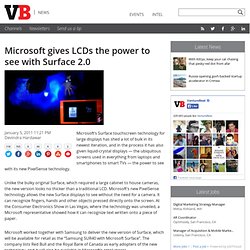
Unlike the bulky original Surface, which required a large cabinet to house cameras, the new version looks no thicker than a traditional LCD. Microsoft’s new PixelSense technology allows the new Surface displays to see without the need for a camera. It can recognize fingers, hands and other objects pressed directly onto the screen. At the Consumer Electronics Show in Las Vegas, where the technology was unveiled, a Microsoft representative showed how it can recognize text written onto a piece of paper. Microsoft worked together with Samsung to deliver the new version of Surface, which will be available for retail as the “Samsung SUR40 with Microsoft Surface”.
Une avancée grandiose va révolutionner l’usage des écrans tactiles - Daily Watch – Lab France 24 / RFI. Violin Memory is music to the ears of those who hate hard disks. Flash memory appliance makerViolin Memory is introducing a new flash memory product today that it hopes will steal market share away from hard disks in corporate data centers.
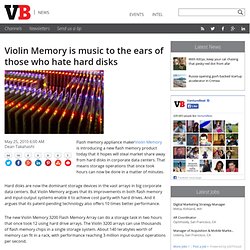
That means storage operations that once took hours can now be done in a matter of minutes. Hard disks are now the dominant storage devices in the vast arrays in big corporate data centers. But Violin Memory argues that its improvements in both flash memory and input-output systems enable it to achieve cost parity with hard drives. And it argues that its patent-pending technology also offers 10 times better performance. The new Violin Memory 3200 Flash Memory Array can do a storage task in two hours that once took 12 using hard drive arrays.
Mountain View, Calif. As more and more computing moves into the cloud, corporations need more reliable storage. Video: Sony’s new, super-thin OLED display wraps around a pencil. OLEDs, which are said to lead the next wave of innovation in the TV space (after back-lit LCDs and 3D displays), come with plenty of advantages: they produce gorgeous images, they are self-luminous, light, and they’re flexible – very flexible.
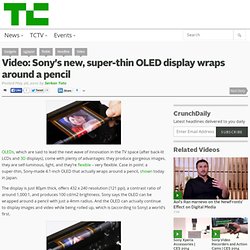
Case in point: a super-thin, Sony-made 4.1-inch OLED that actually wraps around a pencil, shown today in Japan. The display is just 80μm thick, offers 432 x 240 resolution (121 ppi), a contrast ratio of around 1,000:1, and produces 100 cd/m2 brightness. Immersion sees wave of touch-feedback smartphones coming. What's next in mobile?
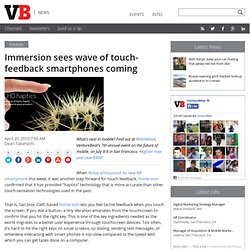
Find out at MobileBeat, VentureBeat's 7th annual event on the future of mobile, on July 8-9 in San Francisco. Register now and save $400! When Nokia announced its new N8 smartphone this week, it was another step forward for touch feedback. Stantum technology presentation. Create Digital Music » The Future of Multi-Touch: Behind the Sce. The Lemur was the first material, commercially-available tool that suggested unlimited-finger touch displays could be expressive in music and visual performance.

But touch is just getting started. Photo by William Crozes; courtesy Stantum; For a long time, technologists have described a world of in which computing experiences naturally incorporate touch and gesture. The question is, how do we bridge the intuitive desire for those interactions and the actual technologies that get us there? Few activities test the expressive potential of interaction quite like music. The history, and products like Apple’s iPad and iPhone, you may know well, though. Top 10 YouTube Videos About Printing 3D Objects.
New GPS Satellites Will Help Apps Better Pinpoint Your Location. Location-based applications are all the rage right now, but anyone who uses them knows that current GPS technology only allows for a certain amount of accuracy.
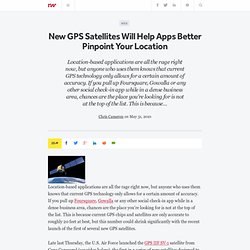
If you pull up Foursquare, Gowalla or any other social check-in app while in a dense business area, chances are the place you're looking for is not at the top of the list. This is because current GPS chips and satellites are only accurate to roughly 20 feet at best, but this number could shrink significantly with the recent launch of the first of several new GPS satellites. Late last Thursday, the U.S. Air Force launched the GPS IIF SV-1 satellite from Cape Canaveral (see video below), the first in a series of new satellites designed to overhaul the existing network that has been providing GPS data for nearly two decades. Boeing has been contracted to build 12 GPS Block IIF satellites, part of an $8 billion government project to replace the 24 existing GPS satellites over the next ten years.
SeaMicro drops an atom bomb on the server industry. Coming out of stealth, SeaMicro is dispelling the Silicon Valley myth that you can’t innovate in hardware anymore.

The startup is announcing today it has created a server with 512 Intel Atom chips that gets supercomputer performance but uses 75 percent less power and space than current servers. It sounds impossible. But if SeaMicro can deliver, then it will deal a big blow to server vendors such as Dell, Hewlett-Packard and IBM. A guide to 3D display technology: its principles, methods, and d.